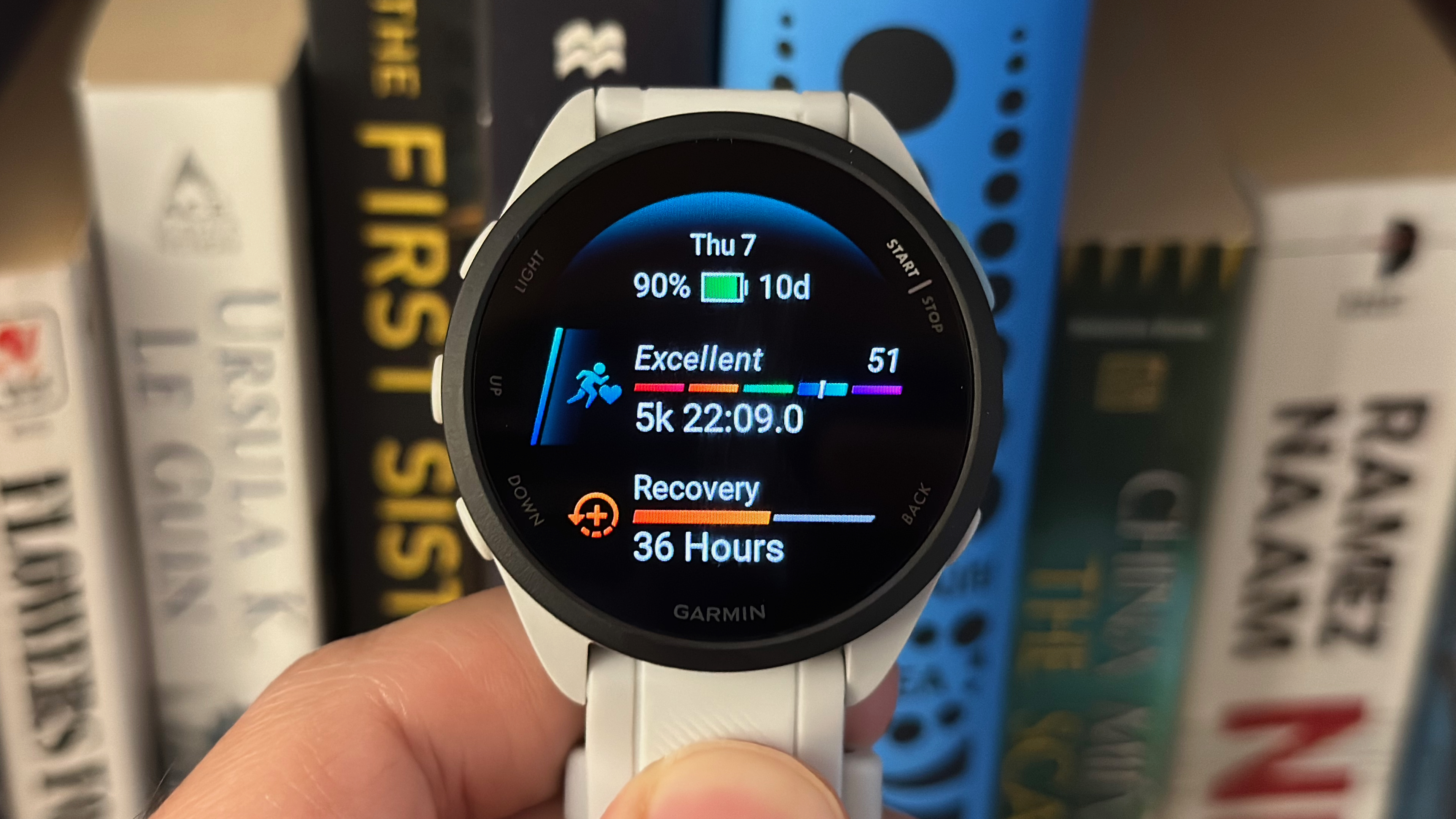Sunday Runday

On this weekly column, Android Central Health Editor Michael Hicks talks concerning the world of wearables, apps, and health tech associated to operating and well being, in his quest to get quicker and more healthy.
For the previous yr, the Garmin Forerunner 965 has been my go-to operating watch; I am going to put on a second look ahead to evaluations, however no different possibility has supplanted it. This month, the Forerunner 165 got here very shut regardless of costing $350 much less.
Technically, I am utilizing the Forerunner 165 Music ($300 much less), however I do not really use the music storage. What issues is that this comparatively low cost Garmin watch has the instruments, UI, and accuracy I might anticipate from a dearer mannequin just like the Forerunner 965.
Regardless that the Forerunner 165 has loads of noticeable compromises to hit that cheaper price level, I can stay with 90% of them — and I like how a lot lighter the 165 is than the 965.
However there’s one lacking Garmin Forerunner 165 function from the Forerunner 265 or 965 that is actually exhausting to go up, it doesn’t matter what type of runner you might be. And it is irritating as a result of it is one thing Garmin might simply supply with the 165’s present expertise.
Why I like the Forerunner 165

The Forerunner 165 might not be as low cost as the unique Forerunner 55 it changed, however I believe most runners will not thoughts the worth creep in trade for all the brand new perks it affords, just like the more-readable AMOLED contact show, improved Elevate v4 coronary heart charge sensor, and multi-GNSS monitoring.
My latest Forerunner 165 health take a look at proved that the watch delivers correct outcomes for steps, coronary heart charge, GPS, and elevation achieve in comparison with different low cost trackers, in methods the extra pedestrian Forerunner 55 could not.
It gave me confidence that I do not essentially want the dearer Forerunners’ dual-band GPS, as a result of the Forerunner 165’s all-systems GNSS mode does fairly properly.

In my take a look at, it beat out the COROS PACE 3, my different favourite low cost operating watch with dual-band monitoring, and the Fitbit Cost 6, our favourite health tracker. Whereas COROS’ watch lasts twice as lengthy with its MIP show, runners who want greater than the Forerunner 165’s 11 days or 19 GPS hours most likely will not purchase a $250 watch. As an alternative, they will desire not having to pressure their eyes to learn notifications.
Just like the PACE 3, although, the Forerunner 165 is satisfyingly gentle and thin. At 39g/ 1.38oz, it is noticeably extra snug than the 53g/1.87oz Forerunner 965. I get used to the 965 throughout runs, however I am unable to ignore its presence on my wrist like I can with the Forerunner 165 — particularly throughout sleep monitoring.
As long as the Forerunner 165 offers me my post-run Coaching Impact information and day by day instructed exercises, I can keep on observe with what I’ve already been doing with my Forerunner 965.
The Forerunner 165’s compromises I can stay with

To make the $600 Forerunner 965 or $450 Forerunner 265 extra tempting, Garmin restricts a bunch of information from the Forerunner 165. Fortunately, I might name most of Garmin’s metrics fascinating however not “important.”
I am unable to deny that the Forerunner 965 helps me observe my progress as a runner. I can see my VO2 Max graph over the previous 4 weeks, plus scores on how my health interprets into Endurance and Hill energy over time. However I additionally assume these enchantment to me out of data-driven vainness, a approach to validate that my coaching is working.
If you actually need affirmation, the Forerunner 165 exhibits your present VO2 Max and a 4-week graph of your predicted race instances; if the projections go decrease, Garmin thinks you are getting quicker. In any other case, as long as you are holding tempo with what Garmin Coach or your day by day instructed exercises let you know, you may sometimes rely on enhancing over time.

Each different helpful Garmin metric — Coaching Standing, Coaching Readiness, real-time stamina, or efficiency situation — is usually helpful for newbie or intermediate runners who do not know sufficient to belief their very own instincts. They quantify your physique’s aches, your wheezing lungs, or that spring in your step.
As long as I’ve Garmin’s day by day instructed exercises as a benchmark for whether or not to coach more durable or pull again that day, that is sometimes all I would like to bolster whether or not I am overreaching, peaking, or slacking off. All the pieces else comes from expertise.
Out of all of the nice-to-have options the Forerunner 965 affords, pre-downloaded topographical maps are the toughest to lose, as a pleasant backup for those who go mountaineering in unfamiliar territory. But when I am trustworthy with myself, I do not go mountaineering all that a lot and use Alltrails once I accomplish that I can address the loss.
Garmin is obstructing the Forerunner 165 from providing its most helpful metric

Past all Garmin’s non-obligatory perks, there’s one information instrument the Forerunner 165 lacks that I am unable to do with out as a runner: Coaching Load. And I am fairly darn positive it might ship that information… if Garmin lets it.
With out getting overly technical, Coaching Load measures how exhausting your physique labored out on a given day primarily based in your coronary heart charge and oxygen consumption. You need to hit a sure Coaching Load each week after which slowly enhance your load quantity each week, both by operating extra or operating quicker.
Your Load is cut up into three coronary heart charge zone classes: Low cardio, excessive cardio, and anaerobic. Increased coronary heart charges offer you extra coaching load in shorter intervals, however high-load runs additionally take longer to recuperate from. A low cardio run is less complicated and causes much less “load” in your physique however slowly helps you enhance your health over time.

All of it sounds very data-driven, nevertheless it’s mainly all about stability. Garmin helps me bear in mind if I’ve accomplished sufficient sprints, intervals, or sluggish jogs just lately, with out having to check my previous exercises. And extra typically, it tells me if I am holding tempo with previous variations of myself or if I am over- or undertraining.

Sadly, Coaching Load is not out there on the Forerunner 165…or is it? As a result of buried in Garmin Join app submenus, I discovered my Coaching Load information, as much as the present date! And I’ve solely used the Forerunner 165 up to now week.
In response to a Garmin rep, although, this Acute Load information is just out there as a result of I have already got a Forerunner 965 related to my account. “When you solely had a 165 in your account, you wouldn’t see the load options in any respect,” she defined. In different phrases, it is an arbitrary paywall relatively than an precise 165 CPU limitation.
I additionally suspect that the Forerunner 165 might present my Coaching Load Focus for cardio or anaerobic runs, if Garmin wished. Why? As a result of similar to the Forerunner 965, the Forerunner 165 takes “the person’s coaching historical past” and “depth” under consideration when suggesting a day by day exercise, in keeping with my Garmin rep.
That features “if there’s a scarcity in a single space (e.g., base to construct up base endurance, threshold to extend excessive cardio coaching),” she continued.
So, with the Forerunner 165, you may take a look at the day by day exercise strategies and guess what Garmin thinks about your present coaching load focus behind the scenes. You simply will not have any means of checking the uncooked information for your self.
My full Garmin Forerunner 165 assessment will come out quickly, however I already assume it is among the finest Garmin watches out there. If I did not have already got each it and the Forerunner 965 in hand, I believe I’d fortunately settle for the compromises of the cheaper mannequin to avoid wasting greater than half off the worth.
I simply want Garmin hadn’t determined to make Coaching Load a function you must pay an additional $200 to get — or $100 extra with the Forerunner 255 — as a result of to me, it is fairly darn important.

Virtually all the pieces you’d need
The Garmin Forerunner 165 arrives three years after the Forerunner 55 with a model new coronary heart charge sensor with HRV standing, way more correct GPS and elevation information, breadcrumb navigation, and an AMOLED contact show. It has new software program methods, too — simply not the Coaching Load function that we actually need.


